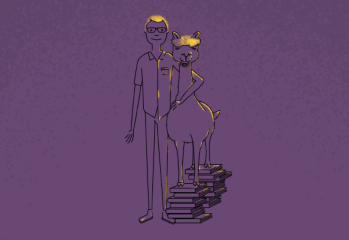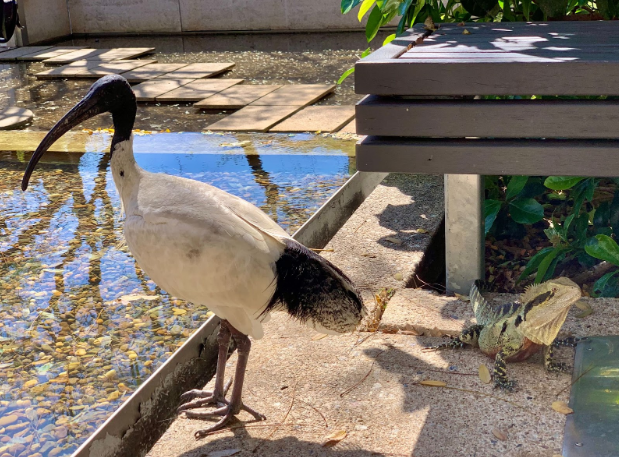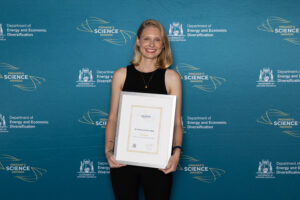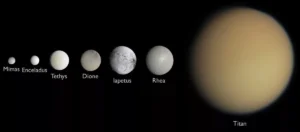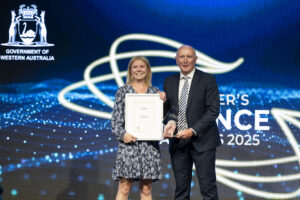Some say the oldest known human settlement is Uruk, in modern-day Iraq. Others say Jericho, in Palestine.
Wherever it is, it must be the place where synurbisation—the process of wildlife adapting to urban environments—originated.
Animals and humans have always coexisted. Before cities, nomadic hunter-gatherers depended on animals for food, transport, and protection.
Since the agricultural revolution roughly 10,000 years ago, the evolutionary paths of animals living among humans have been constantly influenced by our presence.
Our farming, social, and culinary practices have manipulated domesticated species to what we know today. Cats, dogs, poultry, and cattle are all dissimilar from their wild ancestors.
A cow in Beijing – an optimistic future. (credit: Caitriana Nicholson, CC BY-SA 2.0 <https://creativecommons.org/licenses/by-sa/2.0>, via Wikimedia Commons)
According to the United Nations, as much as 68% of the world’s population will live in urban environments by 2050.
Cities are generally considered the realms of people. But it’s wrong to say we live in dense urban environments alone.
An ancient Sumerian proverb, translated from a cuneiform tablet in Uruk, declares: “The fox could not build his own house, so he got a job at his friend’s house.”
So what about the animals forced to lurk in our shadow?
Encampment at the site of ancient Jericho. Coloured lithograph by Louis Haghe after David Roberts, 1843. (Credit: Public domain)
URBAN ORIGINS
Foxes have been archeologically identified in ancient cities dating back to Uruk and Jericho.
All around the world, new animal species are adapting to live alongside humans. As our coastlines recede and our megacities swell, how will this look in the future?
Urbanisation—the expansion of city environments into larger areas—is based on deforestation and land-clearing. As a general rule, species diversity drops once humans dominate an ecosystem.
It’s now largely agreed that the Earth has entered the sixth mass extinction event on the geological record.
In the last few hundred years, rampant pollution and relentless hunting means we have lost a number of species on par with the asteroid collision that eradicated the dinosaurs.
Animals must sink or swim in the 21st century, just ask victims of the deepwater horizon oil spill in the Gulf of Mexico. (credit: Kris Krüg, CC BY-SA 2.0 <https://creativecommons.org/licenses/by-sa/2.0>, via Wikimedia Commons
SYNURBISATION
Urban ecologists have honed in on the species’ learning to live in urban ecological niches.
Synurbisation is the process of animals adapting to thrive in human environments.
Animal species that are thriving alongside human civilisation are termed synanthropic. There are synanthropic animals in cities all over the world.
The most common traits to arise in synanthropes are higher population densities, higher rates of aggression against members of their own species, and a broad-ranging, generalist diet – usually including human waste.
Different from domesticated animals, humans tend to consider synanthropic animals to be unclean, dangerous pests. Sometimes this is warranted.
NEW NEIGHBOURS
Squirrels in Europe and North America are now far more abundant in urban areas than in forests. The same can be said for urban raccoons, foxes, badgers, and even coyotes.
In Barcelona, wild boars rein terror upon fearful residents. Despite her truth-telling hips, Shakira wasn’t spared.
Mumbai’s leopards have been slowly encroaching on the city, attacking the occasional human. Some argue this is ultimately good for public health, as leopards often pray on stray dogs, known carriers of rabies and other diseases, which kill far more people in the area than leopards.
Noisy Miners, bathing on the roof of a supermarket. (credit: Andrew Thomas, via flickr <https://www.flickr.com/photos/58613084@N02/14458275287>)
Dolphins have adapted to urban environments by noticing the warmer waters afforded by coastal power stations. Manatees in Florida also flock to the warm waters of power stations, so much so that their old migratory routes have vanished and the species is now dependent on the fossil-fuel-powered stations.
Even humungous elephants are becoming synurbic.
FENCESITTERS
Birds are among the most prevalent synanthropes.
Most of our city skies have become hyper-concentrated with ibis, pigeons, crested cockatoos that easily open bins, territorial noisy miners, and magpies. Even colonies of flying foxes with individuals numbering in the tens of thousands.
As urbanisation continues, the inter-species housing crisis isn’t going away.
Environmental anthropologist at James Cook University, Dr Gillian Paxton, says it’s an ethical dilemma.
“Do we just say ‘Yes, the noisy miner is a crappy, imperialistic bird. It deserves to be culled, you know, serves it right’?” says Gillian.
Zoonotic diseases are another possible threat – including pandemics. Rats indirectly killed millions during the great bubonic plague.
CREATIVE SOLUTIONS
It’s not as simple as culling and relocation.
“We can get creative with the ways we live together,” says Gillian.
“There is a role for redesigning cities and rethinking urban environments. We need to have cities that are accommodating to wildlife, but that does create problems.”
Luckily, dolphins living near power stations in industrial waterways are becoming more prevalent as the water is slowly cleaned up.
On the other hand, power-station-seeking dolphins in Japan were exposed to radioactivity following the 2011 Fukushima nuclear power plant emergency.
“We’ve always had this idea that wildness and nature is something that shouldn’t be touched, but you can do small things that help,” says Gillian.
Manatees milling in the warm power-station waters. (credit: Matthew Hoobin, CC0, via Wikimedia Commons)
Some people have taken matters into their own hands, eyeing urban ibises as a free food source during the cost of living crisis.
“The most successful thing in managing ibises is to simply cover garbage,” says Gillian.
“But when we say we’re living with something, that sounds very passive, like we just kind of coexist.”
“Living together is more active than that. It involves both parties.”
COOPERATION IS KEY
In the Netherlands, fish must travel through canals in the city of Utrecht to their breeding grounds, but their path is impeded by locks which are sometimes closed.
Ingenious ecologists and conservationists have collaborated to place tiny cameras at the locks. The footage is live-streamed, and onlookers from all over the globe can press a button that grants the fish passage. Like a doorbell for fish.
A lock between local and regional waterways in Utrecht. (credit: E. Dronkert, via flickr, <https://www.flickr.com/photos/dnet/6276736743/in/photostream/>)
Australian researchers are trying to accelerate the evolution of bilbies, so they can better survive encounters with feral cats.
The Floridian manatees are rumoured to be getting their very own publicly-funded hot springs, once their power station homes are phased out.
“There are little exchanges happening, and we don’t really ever point them out,” says Gillian.
“Instead of tolerating the wildlife, we need to cooperate.”
